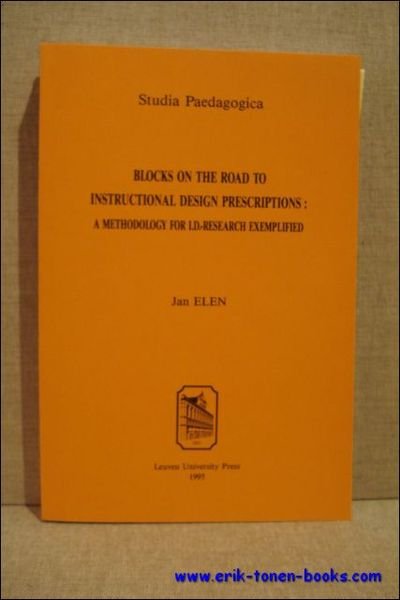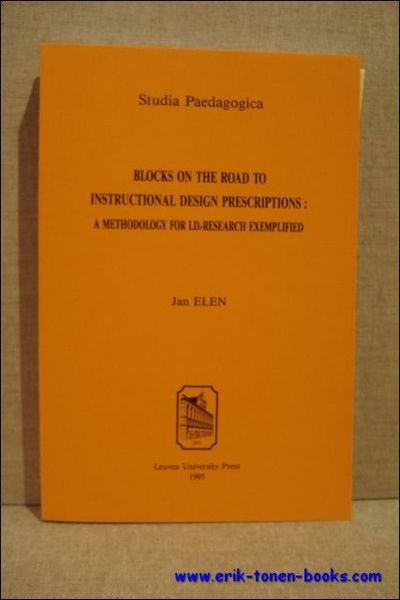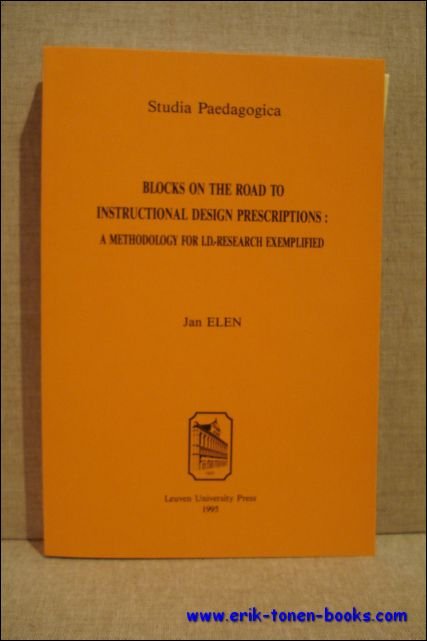Dettagli
Editori
Leuven, Universitaire Pers, 1995
Soggetto
Universitaire Pers Leuven, Universitaire Pers, Universitaire Pers, Universitaire Pers
Descrizione
Paperback, English, original editor's jacket, 16x24 cm., xii-274 pp. ISBN 9789061867081. Studia Paedagogica : 8. The development of instructional design as a linking science and, more specifically, the formulation of theoretically sound, empirically valid, and applicable prescriptions may contribute to bridge the gap between theory and practice. In this study, a heuristic approach is proposed that conceptualizes the steps involved in prescriptive research. It is assumed that prescriptions are tight to learning or cognitive tasks, which represent instructional problems in a specific instructional setting. Furthermore, it is argued that prescriptions are to be embedded in an overarching framework. This framework determines the meaning of the prescriptions, restricts their applicability, and may guarantee their mutual compatibility. I.D.-models have been argued to offer such frameworks. The first step of the proposed approach, then, consists of the construction of an I.D.-model. In a second step, this model is elaborated in order to tune it to the learning or cognitive tasks for which prescriptions will be formulated. An analysis of both the available research embedded in the descriptive knowledge base and the specifications of the referent system, results in a number of problem detection- and prediction-rules. These rules provide indications on problems learners may encounter in their efforts to execute the selected task, or link learner characteristics and instructional interventions to learning outcomes. The last step consists of the validation of the prespecified rules in an ecological setting. This empirical validation may lead to prescriptions which applicability is restricted to the settings specified in the referent system. The approach above is followed as an exemplar of prescriptive I.D.-research. A definition of instructional design is provided and five structural components (descriptive knowledge base, referent system, design parameters, design procedures, and design/development processes) of I.D.-models are identified. An analysis of the influence of cognitive research outcomes on instructional design and the elaboration of the approach for prescriptive instructional design research (Chapter 1), precedes the construction of a cognitive oriented instructional design model (C.I.D.-model). The model is completed by outlining design/development processes and the features of some design procedures (Chapter 2). The model gets further elaborated by taking the referent system more fully into account and specifying the model toward a specific cognitive task: determining importance of information-elements in printed instructional materials (Chapter 3). Considering the outcomes of descriptive research about the influence of both learner and text characteristics on both learning from text and text comprehension, an empirical validation study is presented (Chapter 4). Arguing that descriptive research outcomes cannot be directly transformed into prescriptions, but can help to detect problems students eperience and may suggest possible solutions, problem detection- and prediction-rules are identified. Application of problem detection- and prediction-rules leads to the implementation of three types of interventions or support devices: printing important information bold, integrating important information elements in summaries, and restructuring the text. Results (Chapter 5) indicate that (1) overall, students determine importance by applying a 'safety'-strategy; (2) interventions do not lead to improved performance on determining importance or learning outcomes tests, and (3) content prior knowledge influences performance on learning outcomes tests. Overall, no valid prescriptions can be formulated. The overall non-significant results may be due to a variety of reasons. Retrospective interviews suggest that the results may be explained by the non-use or inappropriate function-attribution of instructional interventions by students. This study does not result in valid prescriptions. In addition, questions are to be raised about the C.I.D.-model and, more specifically, the selection of learner-related design parameters. However, these conclusions pertain only to the hypothesis-testing part of the study and do not consider contributions made with regard to the development of cognitive instructional design, and, more methodologically, the explorative aspects of this prescriptive study.



Scopri come utilizzare
Scopri come utilizzare

